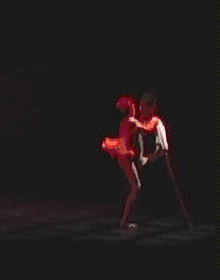Somersault
A somersault (also flip, heli, and in gymnastics salto) is an acrobatic exercise in which a person's body rotates 360° around a horizontal axis with the feet passing over the head.[1] A somersault can be performed forwards, backwards, or sideways and can be executed in the air or on the ground. When performed on the ground it is typically called a roll. Somersault originates from an obsolete French word, sombresault, from Occitan sobresaut; and ultimately Latin – supra, "over", and saltus, "jump".

Types
.jpg)
There are many variations of front and back somersaults. Somersaults can be performed in multiples, or multiples of quarter body revolutions, in some cases with additional twist rotations or ending in body landings, producing variations such as:
- Crash dive (¾ front somersault to back landing)
- Lazy back (¾ back somersault to front landing)
- Ballout (1¼ front somersault to feet from back landing)
- Cody (1¼ back somersault to feet from front landing)
- Barani (front somersault with twist)
- Rudolph (or Rudi) (front somersault with 1½ twists)
- Randolph (or Randi) (front somersault with 2½ twists)
- Adolf (or Adi) (front somersault with 3½ twists)
- Full back or frontfull (back somersault or front somersault with 1 twist) less common with single backs
- Double (double front or back somersault)
- Triple (triple front or back somersault)
- Arabian (half-in, front somersault)
- Arabian Double (half-in, double front somersault)
- Arabian Double half-out (half-in, double front somersault with ½ twist in the second somersault)
- Double full (back somersault with 2 twists)
- Triple full (back somersault with 3 twists)
- Quadruple full (back somersault with 4 twists)
- Thomas (1½ back somersault with 1½ twists to front dive roll)
- Thomas Full In (Thomas salto with an additional full twist)
- Back half-out (double back somersault with ½ twist in the second somersault)
- Front half-out (double front somersault with ½ twist in the second somersault)
- Back in – full out (double back somersault with 1 twist in the second somersault)
- Front in – full out (double front somersault with 1 twist in the first somersault)
- Back Full In (double back somersault with ½ twist in the first somersault)
- Front Full In (double front somersault with a full twist in the first somersault)
- Back Full In half-out (double back somersault with a full twist in the first somersault and an extra ½ twist in the second somersault)
- Front Full In half-out (double front somersault with a full twist in the first somersault and an extra ½ twist in the second somersault)
- Back Double Double (double back somersault with 1 twist in both somersaults)
- Front Double Double (double front somersault with 1 twist in both somersaults)
- Back Double Double half-out (double back somersault with 1 twist in both somersaults and an extra ½ twist in the second somersault)
- Front Double Double half-out (double front somersault with 1 twist in both somersaults and an extra ½ twist in the second somersault)
- Back Triple Double (double back somersault with 1½ twists in both somersaults)
- Front Triple Double (double front somersault with 1½ twists in both somersaults)
Terminology

The names and nomenclature used for somersaults varies among different sports and activities, as well as regionally. In competitive gymnastics and trampolining, standardized names have been assigned to all common variations, which may be performed in tucked, piked, or straight body orientations. Within British gymnastic associations, a crash dive is referred to as a ¾ front somersault (straight). Similarly, a Barani Ballout is referred to as a Ballout Barani to indicate that the forward somersault is executed before the twist.
The word flip is synonymous with an airborne somersault in a number of countries. In contrast, in Britain and some other countries, a flip must rely on the arms to induce body revolution, and the body need not be completely airborne (hands may contact the floor).
The word somerset was also used in Victorian England to describe what today is called a somersault. For example, an 1843 poster advertising Pablo Fanque's Circus Royal boasts, "Mr. HENDERSON will undertake the arduous Task of THROWING TWENTY-ONE SOMERSETS, ON THE SOLID GROUND." [2]
See also
References
- "Gymnastics 101: Glossary of Terms". USA Gymnastics. Retrieved 9 September 2015.
- http://ringlingdocents.org/Mr.Kite.htm